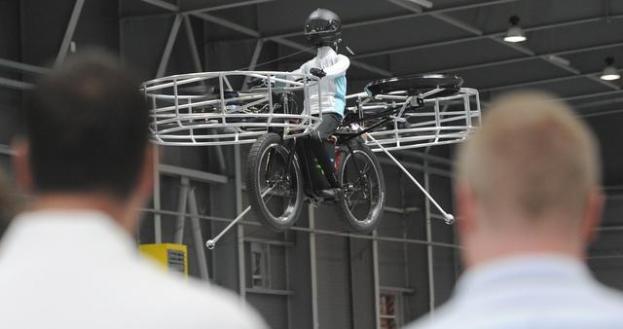 Cycling through heavy traffic can be a risky affair, with vehicles jumping from lane to lane without warning, and pedestrians appearing from nowhere as they risk life and limb to get from one side to the other.
Cycling through heavy traffic can be a risky affair, with vehicles jumping from lane to lane without warning, and pedestrians appearing from nowhere as they risk life and limb to get from one side to the other.
It’d be so much safer if you could avoid these hazards by simply flying above them, while keeping an eye out for low bridges and power lines, naturally.
The idea of a flying bicycle may sound a little far-fetched, but in the Czech capital Prague on Wednesday a group of local companies – including Technodat, Evektor and Duratec – gathered to test out a prototype of such a machine.

The bicycle, which has been in development for a while now, stayed airborne for several minutes (video below), though its creators, presumably fearing the flight may result in a mangled mess, stuck a dummy in the saddle instead of a living, breathing human being.
But they needn’t have worried, as the 220-pound (100 kg) bicycle’s test flight went without a hitch.
The radio-controlled flight was made possible by the bicycle’s six battery-powered propellors, which makes the contraption look a bit like an enormous RC quadcopter. Though the bicycle looked pretty stable during its flight, its large propellors make it look cumbersome to ride and its size means such a bike would face limitations as to where it could go, especially in urban areas. And then there’s all those aforementioned overhead hazards to think about.
Speaking about the project to local news site Ceske Noviny, project participant Ales Kobylik said, “Our main motivation in working on the project was neither profit nor commercial interest, but the fulfilment of our boyish dreams.”
The team said they hope to stick a real life human in the saddle this fall, doing away with the need for a radio controller.
After that, who knows what plans they have for the flying bicycle, though it may be some time before you’ll have a chance to recreate the large-moon-and-a-bicycle scene from ET. I mean, even if you have access to a flying bike, you’ll still need to find a really big moon.
[via Cnet] [Images: Ceske Noviny]


